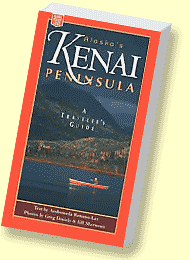

 |
|

|
|

|
|

|
|
 |
|
Alaska’s Kenai Peninsula
In
Anchorage, Alaska, we lean south toward the Kenai Peninsula for good reason.
In darkest winter, that’s where the low-arcing sun hides, a dim orb
taunting us from afar. But beginning each spring -- aah, spring -- that’s
the direction we turn to find so many other wonderful things as well:
fish and berries, trails and wildlife, a thousand secret places to walk
or paddle or listen to the music of glacier-fed creeks splashing across
rounded stones.
The migration begins every May, when I join other urbanites fleeing Alaska’s
biggest city and drive along Turnagain Arm, the Kenai Peninsula’s
northern boundary, to scout for proof of the thaw. The signs -- willow
buds, an occasional bear track -- show up here first, on south-facing
coastal trails. Across the Arm, high valleys sag under their eye-dazzling
burden of snow, and the wrinkles of distant glaciers glow a brilliant
turquoise. In the forest understory, a dozen shades of green spread and
rise like the tide itself. The growing season is short, and the plants
know it.
We know it too, and we can’t bear to waste time. By summer, we’re
migrating to the campgrounds, rivers, beaches, and backcountry trails
of the Kenai in droves, as explorers, prospectors and anglers have been
doing for two and a half centuries. The first European seekers came looking
for a Northwest Passage. It’s not here, of course, as the 18th century
explorer Captain Cook realized after wearily “turning again”
at the head of what we now call Turnagain Arm. Later, the Peninsula tantalized
newcomers with promises of gold, trophy-sized fish, and solitude. Better
luck with these three items: they’re still here to be found.
The Kenai’s easy access makes it an obvious destination for both
Alaska residents and visitors. Ironically, though, easy access obscures
just as many of the Peninsula’s finest attractions. Smooth highways
and roadside espresso stands make it tempting to speed south until you
find a crowded roadside spot where the fish are biting, or until you reach
asphalt’s end, in the seaside towns of Seward and Homer. But by rushing,
you miss out on the Kenai’s secret: The Peninsula is a microcosm
of Alaska. Somewhere within its far-ranging boundaries you can get a taste
of nearly every landscape and wildlife wonder our state has to offer.
Not just fish and forest, but fjords, calving glaciers, ice fields and
alpine tundra. Not just moose, but caribou, beluga whales, sea otters,
seabirds and far more.
On the Peninsula, you can find Alaska’s past, as a wilderness first
prized for its extractable resources, later appreciated as refuge for
both animals and humans. You can meet its diverse people, including the
descendants of Athabaskan, Alutiiq, Russian and pioneer settlers. On the
Peninsula, you can see Alaska’s future, too. The Kenai offers a glimpse
into what happens when people and wilderness exist side by side. (Anchorage,
a city of over 260,000 residents, is just an hour’s drive away. Twice
as many tourists visit the Peninsula each summer.) Fish, moose and brown
bears thrive here, but not by happy accident. Anglers and hunters have
recognized the Kenai as a wilderness worth protecting for nearly a century.
Studies and conservation programs, especially aimed at salmon and brown
bears, recognize the fine balance between trophy species and human crowds.
Kenai Peninsula At a Glance
Size: 9,000 square miles
High Point: 6,612 feet, Truuli Peak on the northwestern
edge of Harding Ice Field.
Climate: Summers are cooler and winters are warmer than
in Interior Alaska, and drier than in neighboring Prince William Sound.
Summer daytime temperatures range from the high 40s to the low 70s (coolest
along the southern coast, warmer inland). In winter, temperatures range
from 30 below zero, to 30 above. The Kenai’s mountainous eastern
half is wetter than the Cook Inlet-moderated western half; annual precipitation
varies from 19 inches at Kenai, to 25 inches at Homer, and 67 inches at
Seward. Wherever you go, a warm hat, fleece jacket, waterproof shell and
waterproof boots will make your stay more comfortable.
Location/Access: The Kenai Peninsula is located in Southcentral
Alaska, about 50 miles south of Anchorage. It is accessible by car along
the Seward Highway, as well as by bus and train from Anchorage. Regularly
scheduled air service is available from Anchorage to Kenai-Soldotna, Seward
and Homer. The Alaska Railroad offers scenic summer rail service between
Anchorage and Seward, along a 114-mile route that climbs mountain passes
and skirts several glaciers.
Driving notes: Two major highways bisect the Kenai Peninsula.
The 127-mile long Seward Highway, one of Alaska’s most scenic routes,
connects Anchorage to Seward. Ninety miles south of Anchorage, the Sterling
Highway branches off from the Seward Highway and continues for 143 miles
to Homer. Both highways are open year-round, though avalanche activity
can close the Seward Highway for short periods. On the Seward Highway,
motorists must drive with headlights on at all times. On both highways,
backups caused by slow vehicles are common. To look for roadside wildlife,
stop at signed pull-outs and take a detour along the central Kenai’s
Skilak Lake Loop Road, a restricted-hunting zone where animals are more
frequently spotted.
Visitor Centers: The Begich-Boggs Visitor Center in Portage,
en route to the Kenai Peninsula from Anchorage, is the state’s most-visited
attraction, offering views of Portage Glacier, observation decks with
spotting scopes, short interpretive trails, exhibits on glaciers and wildlife,
and a theatre that runs films about Alaska’s famous ice. The Kenai
Fjords National Park visitor center in Seward’s Small Boat Harbor
has a good bookshop and can answer questions about the park. The Kenai
National Wildlife Refuge visitor center in Soldotna offers maps and wildlife-watching
brochures that will help you find your way around the less-used trails
of the refuge. The Kenai Bicentennial Visitors Center offers brochures
on local B&Bs, fishing charters, and other local attractions, as well
art and historical exhibits. Soldotna has its own Kenai Peninsula Visitor
Information Center, in the center of town on the Sterling Highway. On
the highway leading into Homer you’ll find the Alaska Maritime National
Wildlife Refuge Visitor Center, with displays, a small theatre, and summer
programs.
Bird-Watching: Shorebird lovers should consider coming
to the Kenai in early May, when hundreds of thousands of migrating shorebirds
descend on Kachemak Bay. June through August is the best time to see seabirds;
boat-tour destinations include the Chiswell Islands, near Seward, and
Kachemak Bay, near Homer. Good road-side birdwatching spots include Tern
Lake at the junction of the Seward and Sterling Highways, Skilak Lake
Loop Road near Cooper Landing, Warren Ames Bridge in Kenai, Anchor River
Road in Anchor Point, and the Homer Spit. More than 200 bird species have
been tallied in the Chugach National Forest.
Fishing: An Alaska fishing license, purchased easily
from most grocery stores, gas stations and sporting goods shops, is required
for all fishing. An additional king salmon fishing tag is required for
those pursuing Alaska’s largest salmon species. Fishing opportunities
include river fishing for salmon and rainbow trout, especially on the
Kenai and Russian Rivers. Lakes in the Chugach National Forest and Kenai
National Wildlife Refuge offer more secluded fishing for grayling, arctic
char, lake trout, and rainbow trout. Deep-sea halibut charters depart
from several Cook Inlet and Kachemak Bay communities. The Seward Silver
Salmon Derby (August), and the Homer Jackpot Halibut Derby (May 1 to Labor
Day) offer cash prizes to ticket-holders who catch the largest fish.
Contact Alaska Department of Fish and Game (907) 267-2898 for fishing
updates and regulations.
Hunting: Licensed hunting is allowed on some Kenai Peninsula
public lands. Species include caribou, moose, black bear, Dall sheep,
mountain goat, and ptarmigan. Contact Alaska Department of Fish and Game
for regulations.
Paddling: The 60-mile Swan Lake Route and the 80-mile
Swanson River Route are both part of the popular Kenai National Wildlife
Refuge Canoe Trail System, allowing canoeists to fish away from the crowds
and spot more reclusive loons, bears, moose, and rarely, wolves. Sea kayakers
can explore miles of coastline along Resurrection Bay and the south shore
of Kachemak Bay, or can arrange remote drop-offs in Kenai Fjords National
Park. Canoe and kayak rentals and guided sea kayaking tours are available
throughout the Kenai.
River Rafting and Kayaking: Cooper Landing and Hope are
the respective starting points for river rafters and kayakers wanting
to join guided floats of the Kenai River (Class I-III) and Sixmile Creek
(Class III-V).
Cruise Ship Tours: Large cruise ships dock in Seward.
Smaller sightseeing boats depart daily in summer from Seward for half-day
and day-long tours of Resurrection Bay and the Kenai Fjords. Sightseeing
boats as well as water taxis depart Homer daily in summer for trips across
Kachemak Bay.
Hiking and Mountaineering: The Kenai Peninsula has over
300 miles of developed hiking trails and many more backcountry paths.
The 38-mile Resurrection Pass Trail is the Peninsula’s most popular
multi-day hike through the Chugach National Forest. Linked with the Russian
Lakes and Resurrection River trails, it is a 7- to 10-day trek from Hope
to Exit Glacier near Seward. The 23-mile Johnson Pass Trail, once part
of the Iditarod Trail from Seward, is another popular overnight hike in
the Kenai Mountains. The 15-mile combined Primrose and Lost Lake trails,
near Seward, offer good views of the alpine countryside. Kachemak Bay
State Park, the Kenai National Wildife Refuge, and the Caines Head State
Recreation Area near Seward all have their own diverse networks of trails.
Kenai Fjords National Park, best visited by boat, has few developed trails,
with the exception of the half-mile trail to the face of Exit Glacier,
and a steep and snowy 5-mile (one-way) trail to the Harding Ice Field,
at 3,500 feet. From trail’s end, well-equipped mountaineers can venture
further onto the ice field.
Camping: The U.S Forest Service maintains backcountry
campsites and over a dozen roadside campgrounds near Hope and along the
Seward and Sterling highways. Those closest to the Kenai and Russian rivers
fill early. Slightly less crowded are the Kenai National Wildlife Refuge
campgrounds on the Skilak Lake Loop Road. The National Park Service operates
a tent-only campground on the road to Exit Glacier. Kachemak Bay State
Park has rustic tent sites. Seward, Homer, Kenai, Soldotna, Anchor Point,
Ninilchik, Calm Gulch, Kasilof, and the Captain Cook State Recreation
Area all have waterfront campgrounds and/or rustic campsites that tend
to be mobbed during salmon runs, and quiet the rest of the summer. For
more information, contact land agencies directly or visit the Alaska Public
Lands Information Center in downtown Anchorage, 405 W. 4th Ave.
Copyright 2001 Andromeda Romano-Lax.
All rights reserved.



